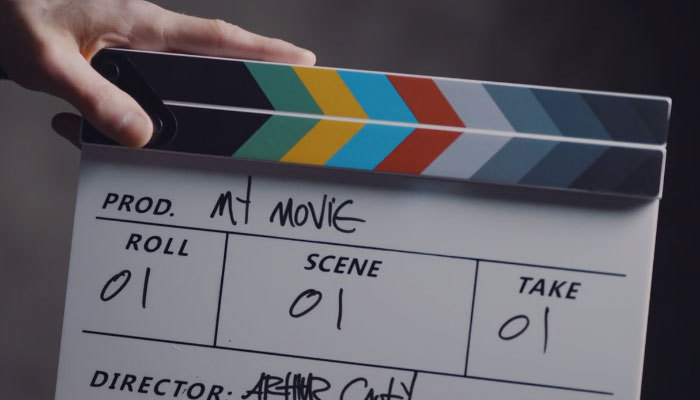Today we’re talking with Michael Andrews, ACE, editor of the incredible animated feature, Spider-Man: Across the Spider-Verse. Anyone who has seen this has to just be in awe of how something like this got made - and Mike’s gonna shed some light on that for us.
Mike’s credits include editing Paws of Fury: The Legend of Hank, The SpongeBob Movie: Sponge on the Run, Mr. Peabody and Sherman, Megamind, Shrek, Shrek 2, and Shrek the Third. When you figure that each of those was probably a multi-year commitment, that is a lot of animation editing experience.
Art of the Cut: Spider Man Across the Spider Verse
I saw it last night with a packed house. Not at a Hollywood premiere or anything, just a regular group of people that really wanted to see this movie and they were cheering throughout the film!ANDREWS: No way, wow!
Especially at the end. The “Spidey T-Rex” came out and the audience just went insane.ANDREWS: It's so rewarding to hear people respond that way.
I loved the opening Gwen drum solo montage. Tell me a little bit about creating a montage like that. What were you given? What did you have to do with it? How did you teach the audience about what they're about to see?ANDREWS: That was always part of the plan to let Gwen's story start the opening of the movie. There was a roughly storyboarded version that I began with and we just kept building upon it.
I did a lot of sessions with Phil Lord. He was always trying to push it further and further. I pulled things from YouTube, he got really fascinated by some of these slow-motion shots of people drumming with paint bouncing off the drum skin. I used some of that.
It was a hard sequence to wrangle because then we had to hand it over to the layout department. They came in with a bunch of shots and we were always adding layer after layer. On top of that, the music was changing here and there because we originally did it all to a track that the composer Daniel Pemberton had created for us early on but it wasn't necessarily built for that scene. As he rewrote the music and started providing the score, we finally had something we could use.
Animation was adding their own touches. There are a lot of shots in that sequence that are either from the first movie or from later parts of this movie and we didn't want to show them in the same style as you would see them or as you saw them in the first movie. I was working on it from day one until a few weeks ago.
What was the total span of that time? From day one to weeks ago?ANDREWS: I came onto the movie a little over two years ago, I think it was May 2021. There was someone before me who left the show. They had already been working on it for about a year, it was in a very rough place when I came on. I just picked it up and hit the ground running and never stopped.
People from ‘Art of The Cut’ know the usual way animation gets edited. This could not have been like that. Tell me a little bit about what you're editing with beyond storyboards.ANDREWS: We do start with storyboards as much as possible because that's the best way to figure out where you're going. It's the equivalent of the pre-production phase for us. We're helping write the movie basically because we're trying to come up with all the building blocks that you need to make the story land. You don't wanna kick off production too early, that's when it gets expensive. You want to review the whole movie and storyboards a couple times at least to make sure you're on the right path before you put it into production.
While the layout department is working out all the cameras we're still working on the story rewrites, trying new lines, trying new beats. Trying to get all the emotion out of it that we possibly can before it's too late. Then it moves into animation after layout.
I love that! We've talked a little bit about storyboards but you also mentioned using YouTube videos. It seems like some of the movie at least is mocap, were you using actual mocap performances?ANDREWS: No, actually there's no mocap in it whatsoever.
There's no mocap? Wow!ANDREWS: The last time I was ever involved with any mocap was when I was at Dreamworks. Dreamworks had a very nice elaborate mocap stage. It wasn't used for animation, I think the animators would've rioted if they used mocap to take over their jobs.
It was used in a very smart way on certain shows. It was actually used for layout, for creating the staging and the blocking. It came in very handy for that. We did not do that on this, we did not have access to a mocap stage.
That's so interesting. So you are editing with storyboards until you're actually getting some kind of a layout. Explain layout to people. Once you're done with a storyboard scene, where does it go and how does it come back?ANDREWS: When it is "Ready to go" to layout which it never is actually "Ready to go" we just send it anyway. We work more directly with them than anyone between story and layout. Story comes in and layout goes out. We give them our cut and they go in to start building the shots. This is when it becomes production. They follow the cut, follow what shots we use and basically set up a general layout pass of the entire sequence, the sequence hopefully being under three minutes.
It's mostly just to set up cameras, set up the positions of the characters, what props they're gonna need, what the set should look like, what angles we need.
That something can move in 3D space in the correct amount of time.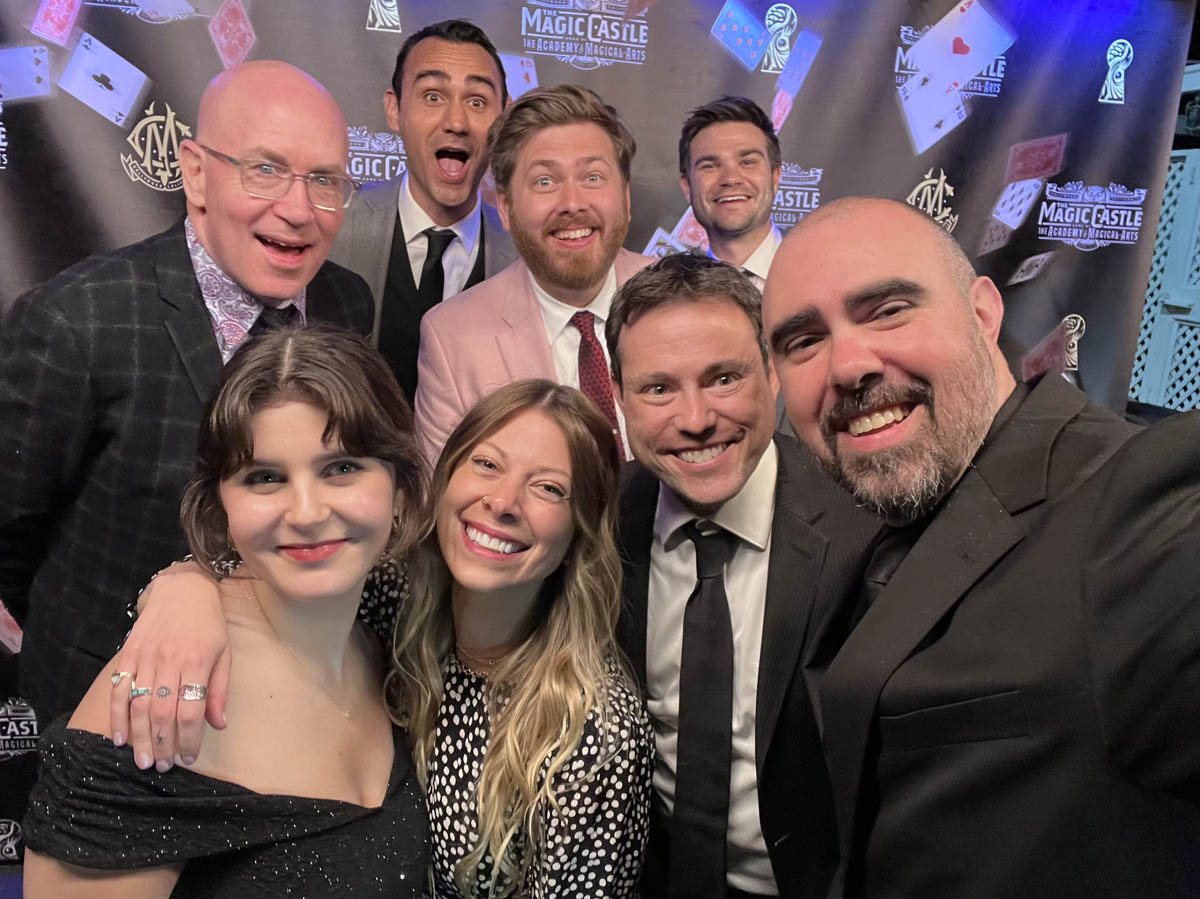
Spidey post team at a recent celebration at Magic Castle in L.A.
L to R - front row - Nina Lentini, Erika Scopelli, Andy Leviton, Freddy Ferrari;
Second row - Michael Andrews, Chett Hoffman;
Back row - Josh Perez, James Adams
ANDREWS: Yeah, exactly. We're going from 2D storyboards into a 3D space, we're getting into the real world. It's a little cruder looking than what it will look like even in the animation phase but that just allows us the flexibility of trying to work loosely until we nail it down.
I've seen layout done many different ways. Usually, most shows start off by saying we're going to do pre-vis, we’ll give you tons of footage, tons of coverage and you'll be able to cut all kinds of things. Then the clock starts ticking and we run out of time then they go "No, we're just gonna do the shots." I would love to have that kind of coverage. I would love to have that flexibility but I could count on one hand how many times someone's given me the actual coverage that you would get in a live-action movie.
I just talked to somebody on Star Trek Picard and they said their animation team, they're just animating spaceships. They would do multiple angles, multiple approaches, and take-offs because they could but with something as complex as what you were dealing with, they don't have that time.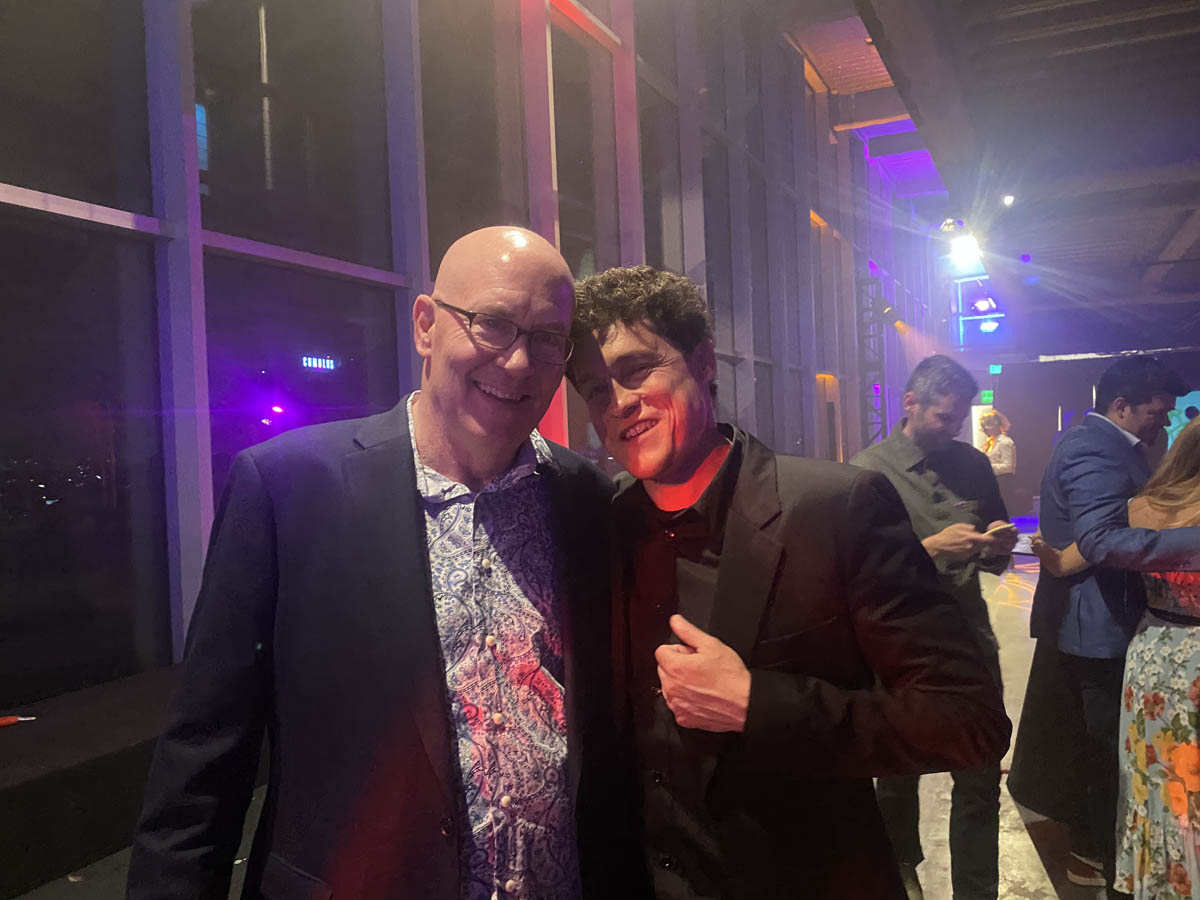
Editor Mike Andrews, ACE with Phil Lord
ANDREWS: There's this other system that's really cool called Camera Capture. Dreamworks had a room and you'd have this camera where you're virtually able to walk around the sets. You could set the angles wherever you wanted to.
It reminded me that the very first time I ever laid my eyes on Phil Lord and Chris Miller. I was watching a Saturday morning show with my son and it was like an infotainment kind of show. They were interviewing Chris and Phil. Chris and Phil made "Cloudy with a Chance of Meatballs", they were demonstrating how Camera Capture works and they were doing a scene where the character was running through a house. The scene is animated as a whole, then you use the Camera Capture to go shoot it as if you're shooting a live-action movie.
It was a very active scene, you basically had to chase the character through the house and try to keep up with them. They showed how the movie did it and then they turned it over to the host who tried to do it and it was just a mess. It just made me think it'd be a great way to work but it's cheaper and it's quicker for the production team just to set up shots and only concentrate on those shots.
My first feature was Shrek. After Shrek, there was a moment where we were gonna do a 3D IMAX version of the movie and we spent a year developing this thing. I learned so much from that. The first thing I learned is that once we open the screen up to IMAX, anything off the screen wasn't animated. So if it was a waist-high shot of Shrek, his legs were just dragging and twisting. They wouldn't even animate outside the film frame, all that had to be touched up to make that work. I didn't even realize "Oh, they don't even bother."
 Chris Miller and Phil Lord at the Spidey mix
It's like a Zoom call, you could be wearing shorts or you could be wearing nothing at all below there! (Joking)
Chris Miller and Phil Lord at the Spidey mix
It's like a Zoom call, you could be wearing shorts or you could be wearing nothing at all below there! (Joking)
ANDREWS: I do have pants on. I do, I swear! (Joking)
I think in Avatar, they used that idea of the camera capture where Cameron was actively moving a camera inside of a space that had already been acted.ANDREWS: He is cutting edge in all that stuff.
What about the use of split screens? Is that something that was storyboarded? There are a couple of places where you split screen, I thought that was really interesting.ANDREWS: That was often a choice made during production where we thought "Oh, we could say two things at the same time." The beauty of doing something like Spider-Verse, which is comic book based, is that it’s a comic book world. The cutting can be different. When you look at a comic book they break angles all over the place. There's rarely any kind of clean continuity to it all.
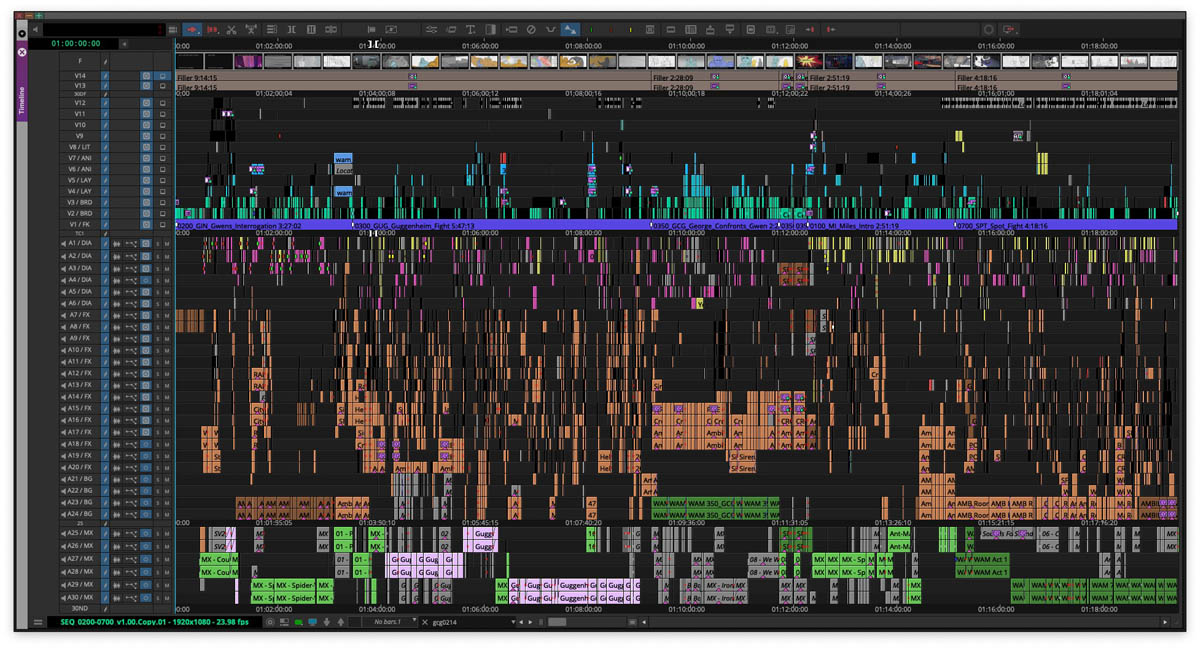 Avid timeline for the first screening June 2021
There's no 16:9 in a comic book.
Avid timeline for the first screening June 2021
There's no 16:9 in a comic book.
ANDREWS: Any frame, any angle, you could split screen and you could put text on screen. There are the editor's notes, which we took full advantage of to try to explain some of the things the character Hobie was saying because he spoke in a very thick cockney accent. Things like that come in very handy, it really helps us tell the story. We're just not following traditional framing and cutting so I enjoyed that aspect of it.
There are some really big tonal shifts including inside of a scene. Can you talk about managing those? Is that something that you had to experiment with when you were in the storyboard phase? Or even as you were seeing more final production stuff?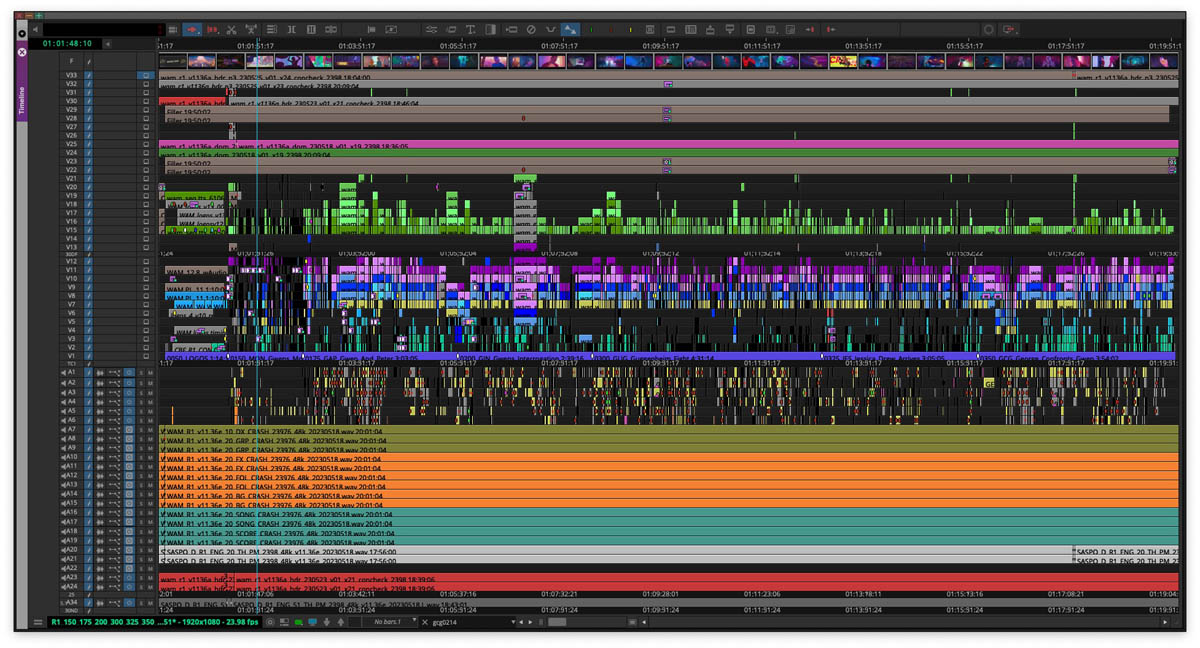
Avid timeline for the final screening
ANDREWS: Storyboards are usually suggestions of what things will be. Some storyboard artists are incredible and practically animate it for you and give you all the goods. Some give you nice drawings but sometimes you need a little more because we have to screen it for the studio and an audience completely in storyboards to sell the whole idea and to figure out where we're going.
In order to make that happen with these little sketchy drawings we can milk stuff that you don't have the performance from a human being to actually help. That's why we layer heavily with music and sound effects and we make it as much of a complete film as possible early on.
Early on we were working with scratch actors and oftentimes it's just people around the office. My own crew I call the ‘editorial players’ because they did all the voices for us and filled all the gaps. I always made the jokes that we were putting on a play and I was making costumes out of curtains.
Once you get the actor's voices in you're like "Okay now we're reaching a whole new level." Oftentimes the scratch performances are great but they're not as drawn out or they lack the performance that the beat needs, which is what the actor finds. Phil is amazing at finding those moments to focus on and open up. He knows when not to overdo it. He knows when to put in the emotional beats that we need.
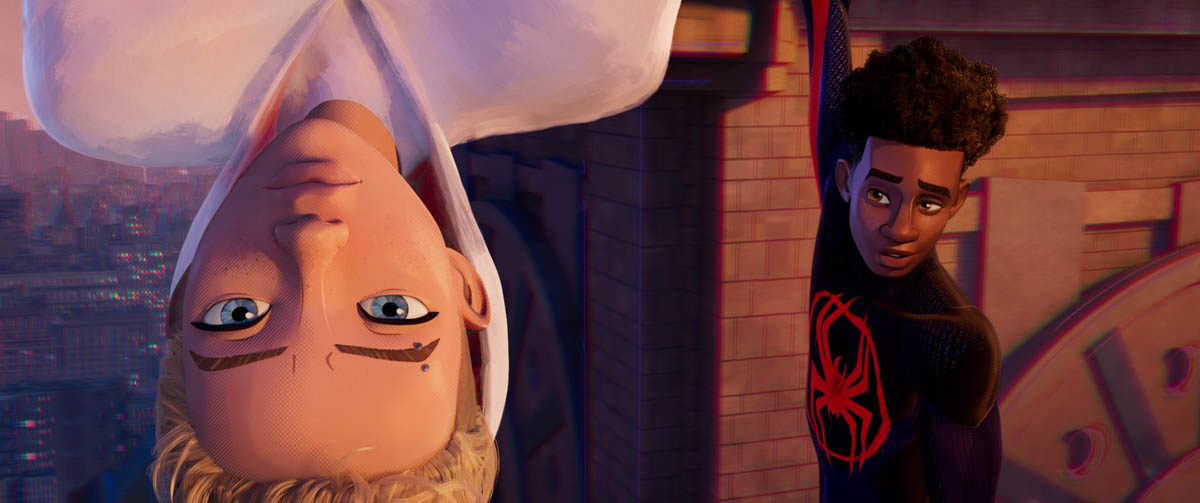
Every time Phil would say "We need to open it up" this little voice in the back of my head was like "Oh, getting longer!" - but the thing about Phil is he's always right, he nailed it every time. There are a couple scenes we did pretty late in the game and one of them is when Miles comes home and has a moment with his mom. There's a little bit of a twist to that scene but his conversation was something that we've added fairly late in the game and it came out of preview response. They felt they needed to feel Miles have some moment of success where he feels like he's conquered something in the movie. It is a cliffhanger movie and we didn't wanna just make people feel "Oh, that was an unsatisfying ending because what about Miles?" This allowed us to have a moment of success for him.
I can't even count the number of days Phil and I spent on that. It was probably like two weeks of sessions and we just kept reworking. We recorded Shameik Moore twice in that time period just to nail it down. It was a rough one but in the end it's very satisfying, it's full of emotional pauses that all work.
I was going to bring that scene up when you were talking about storyboards. You were talking about the fact that you sometimes don't even have the actors. It must be so hard to judge timings and how long you should hold onto a touching reaction of the Mom when you're looking at a storyboard and listening to your assistant editor!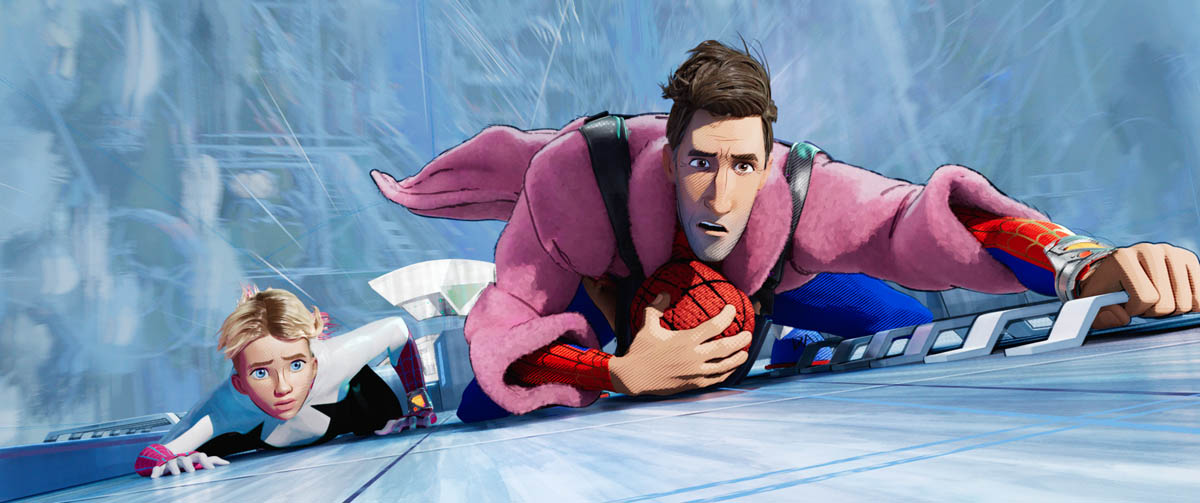
ANDREWS: Exactly, it's funny! I felt they were all really good at pulling off the voices. My first assistant Erica did a lot with the mom and she was great. She's actually done some acting in the past so she was really good. We're staring at a simple drawing and it's not easy to give facial performance nuance in drawing.
Some people can pull it off and sometimes all it takes is an eyebrow raise and you're pretty good. It can be done and that's where our score came in very handy. Luckily we had Daniel’s score from the first movie who we worked with. Sometimes you're working with score from random movies and I was trying to stick with either our first score or another score that Daniel had done for other movies. We just fake it until we get something, everything builds upon that from there.
I have no clue how you could have dealt with the energy and rhythm changes, it changes within one shot!ANDREWS: I have to say of all the movies I've worked on I feel like more effort per frame went into this movie than anything I've seen. I feel like when I saw the first movie I was like "Gosh, I wish I was part of that. How did they do that? How did they make that movie?" I thought it was so groundbreaking and that was one of the reasons I wanted to come aboard, I wanted to see how these guys worked.

Phil has three directors - Joaquim Dos Santos, Kemp Powers and Justin Thompson. Those guys all have their own little superpower that they bring to the table. Justin was the production designer on the first movie, Kemp Powers co-directed Soul for Pixar. He's a fantastic writer and he was always the voice of reason. Joaquin Dos Santos is possibly the best board artist I've ever worked with, it's just unbelievable what he can do. It made our lives so much easier and he has a rare talent where you can board action and actually animate the camera in the storyboards.
For the scene between Miguel and Miles on the train, we had to check a number of times to make sure the layout had set up cameras in the places needed to make it as dynamic as the way Joaquin had boarded it. You'd think from the storyboards onwards everything would automatically get better and more interesting but that's not always the case.
Phil would see it and we'd go "What happened here? Something's wrong.” We'd have to go back and I keep everything in the timeline so I can always go back. That happens a lot with comedic moments too. You go "Oh wait, why isn't it funny anymore? What happened?" Then you check and go "Oh, they made more of a dramatic angle out of it." So that kinda thing happens all the time.
I've seen that the storyboard has a lot more feeling to it just because it's drawn and then you get to the layout and it's like a video game. It has no emotion to it whereas the storyboard has.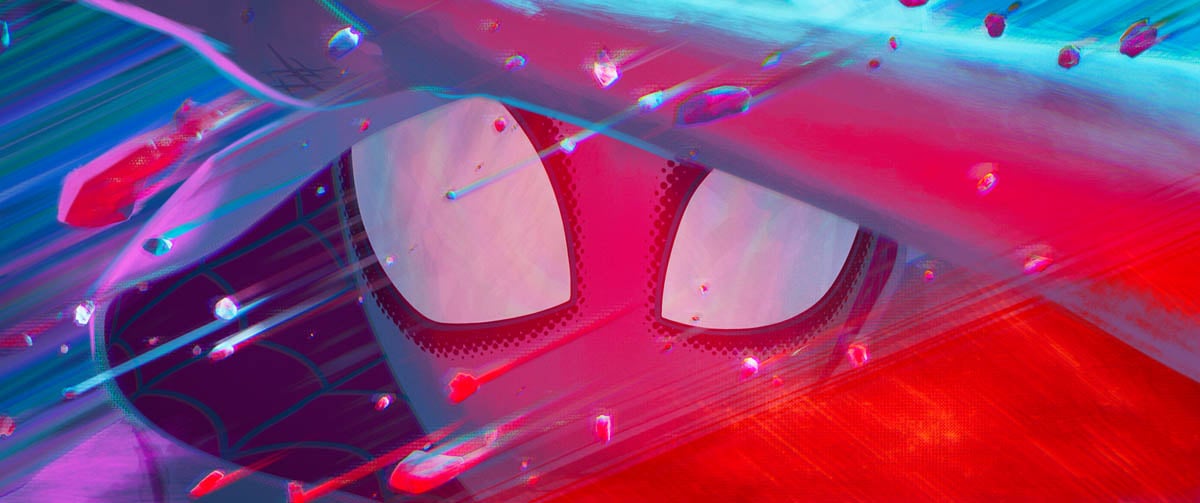
ANDREWS: They do such a great job but their work never gets screened usually, unless it's like an action sequence. Some people have tried to make layout where the characters are talking, but it's really not the purpose of layout. I'm not playing it down in any way, it's a very crucial step and I love working with them.
Has that improved? Have you seen improvements in the amount of time you've worked in 3D on the way the layout looks?ANDREWS: Definitely, I mean I've already dated myself all the way back to Shrek but back then they were in T poses and moving like Gumby.
That's what I've seen! It looks like a chess match, with the characters just sliding around on a board.ANDREWS: That's the simplest, crudest version. Over the years it's definitely gotten better. It's got to a point where I've seen layout departments show they could actually do a story and that has happened a couple times.
.jpg) Let's talk a little bit about the use of reaction shots to sell story, truth, and emotion. You're in the unique position as an editor on an animated film to say "I want this specific reaction from a specific angle." Let's talk about using reaction shots.
Let's talk a little bit about the use of reaction shots to sell story, truth, and emotion. You're in the unique position as an editor on an animated film to say "I want this specific reaction from a specific angle." Let's talk about using reaction shots.
ANDREWS: I'm a big fan of reaction shots, some of my favorite shots in the movie are reaction shots. There was a simple shot that I laughed at every time. It's when Spot, Miles, and his father are all down in the pit where the collider was and Spot says "You make all your stupid little jokes and everybody laughs at them." Jeff and Miles just look at each other and Jeff lets a laugh slip. It's just the simplest little reaction and I've always loved it. We have to request them often because the way things are storyboarded, people tend to concentrate on what they think we should be looking at, which is the person talking or whatever action is taking place. So sometimes we do have to request it.
Sometimes you need to see how people are reacting to what they're saying, that doesn't always come to mind with all board artists. Sometimes we do have to request stuff. With some of the stuff Joaquin did on the train there were moments where we realized we’ve got to keep this pinned to miles. “How is he seeing all this”, "How is he taking in all this information?” We had to stop and go “Let's get a nice close-up of miles.” So we see how he is taking in the scene. Those things are crucial.
It's interesting because I've worked on more live-action stuff. You can be prompted for a great reaction shot because in the dailies you see somebody roll their eyes and you're like "Oh my gosh, I've got to put that in." but for you it's "I have to THINK about that.".jpg) I interviewed the Guardians of the Galaxy editor, obviously that's mostly live-action. He said they didn't have a reaction shot of Rocket at this certain moment and he cut the whole scene together. He thought it was great. Then the director said we need a reaction shot of Rocket when he hears this one line, but it doesn't exist right? You've got to think of something that is not in your toolbox.
I interviewed the Guardians of the Galaxy editor, obviously that's mostly live-action. He said they didn't have a reaction shot of Rocket at this certain moment and he cut the whole scene together. He thought it was great. Then the director said we need a reaction shot of Rocket when he hears this one line, but it doesn't exist right? You've got to think of something that is not in your toolbox.
ANDREWS: The film evolves and finds a way. We watch them so many times the only danger is we get numb to them and we're not seeing what we need to see. There are times where I'll just sense something is missing right here. It's often a character moment of someone taking something in. I feel like in movies we do have that luxury, it's a luxury and a curse at the same time. We can build from scratch at all times. In a weird way our worlds are getting closer together, between the animation and live action because now the editorial team starts from day one on the animated movies. As soon as there's a storyboard to cut together we're there and we're there to the bitter end. The concept of pre-production, production and post-production. Editorial mostly being post-production, maybe a little bit during production. Their schedules are getting earlier and earlier too because there's so much pre-vis being done and so much CG work.I feel like our worlds are getting closer than they were before.
There are some great sections of overlapping dialogue. Can you talk about trying to build that?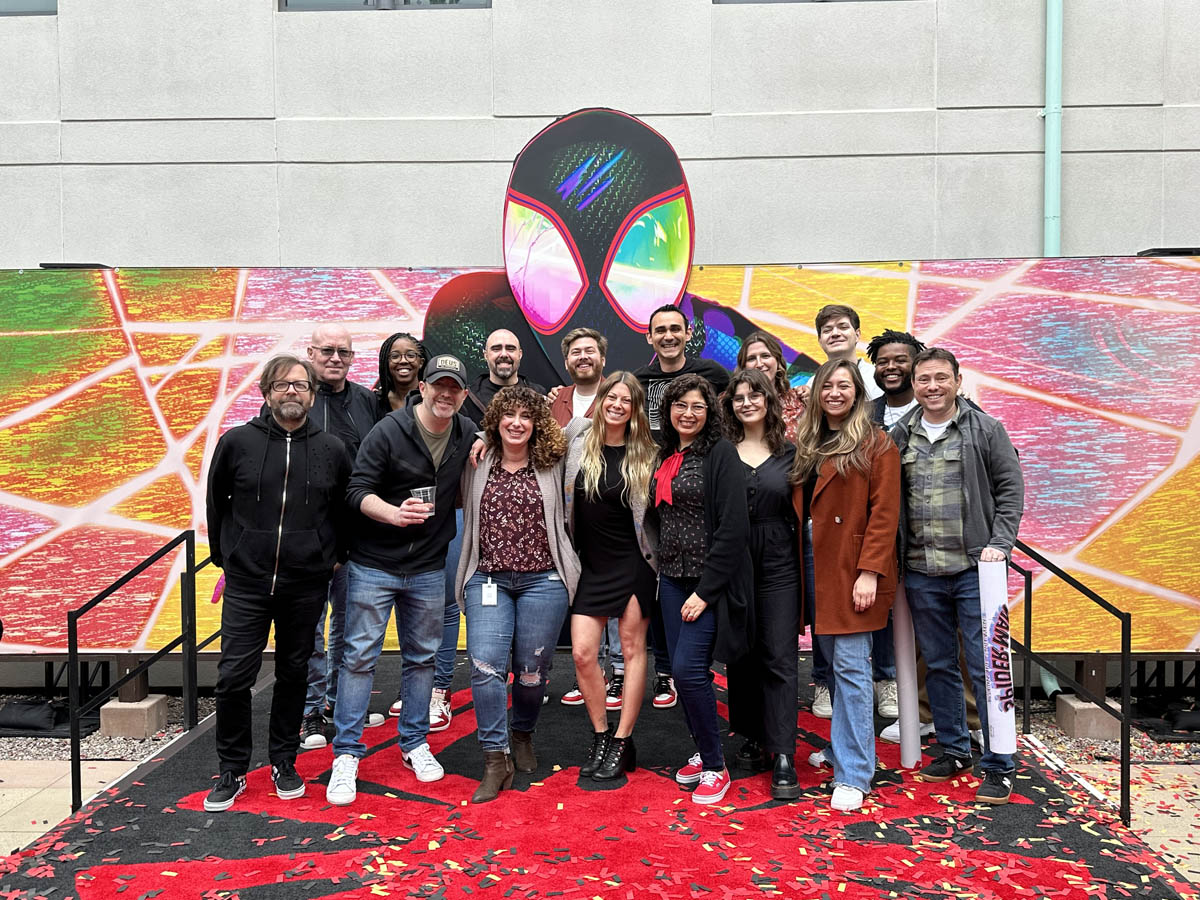
Spidey post team and other members of the production team
ANDREWS: Over the many years I've been doing this I've seen it tried where they put actors together and it doesn't always work. We did it a couple times in this movie, just to help the actors and Phil encourages ad-libbing which gives us a lot to choose from. They did that with Miles and Gwen, Phil didn't want to inhibit them in any way by putting them in sound booths, we didn't do that much. We did that just a couple times, like I mentioned.
Let's talk about modulating dynamics. I thought that was lovely in this film. Sometimes inside of a scene but also throughout the whole film there are these ‘balls to the wall’ action scenes. Then there are these lovely moments of drama or heartfeltness. I love the stuff up on the rooftop with the parents, that's got some great emotion to it. Can you talk about being able to feel those dynamics, when they need to happen and when they've gone on too long.ANDREWS: I think we succeeded at layering plenty of emotion in this movie. It makes me very happy because it's very easy for the movie to just feel like stuff going past your eyes with no emotion or depth to it.
Phil is very conscious of emotion being the driving factor to everything. He pushed for it every step of the way. One of my favorite scenes is the scene between Miles' mom at the party. After Gwen leaves they have a little heart to heart moment. He almost tells her who he is but doesn't, then she comes back and says "You should follow Gwen." She tells him to go on his way but she also says you're going into the world. For me it's crushing because my son is 17 years old. It really hits me in the heart because my son is going into the world and in that scene Miles is going into the world.
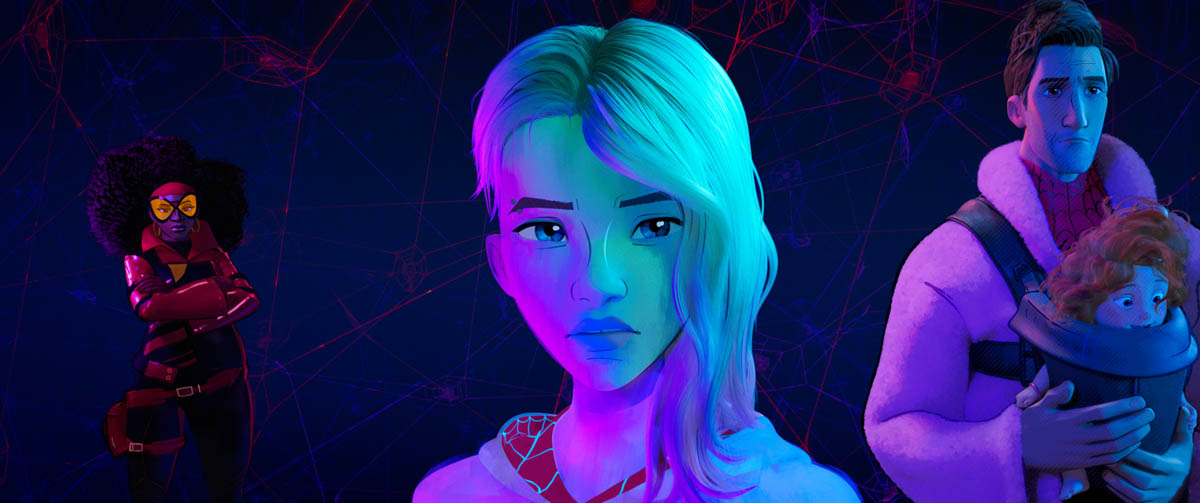 I got the opportunity to see this movie last night with my daughter who is 27 years old at the moment. I thought many times "I hope she heard that line" because it's certainly how I feel.
I got the opportunity to see this movie last night with my daughter who is 27 years old at the moment. I thought many times "I hope she heard that line" because it's certainly how I feel.
ANDREWS: Gwen really comes into her own in this movie. She has the whole opening to herself. A lot of people along the way, myself included, questioned whether that was the right way to go. Phil was very strong-willed about it and thought we have to lay the groundwork for all the decisions that Gwen makes in the movie. We kept building upon that, having the scene with her father, having the scene with her friend Peter. This is all going to add up to something and it truly does.
What's crazy to me is the movie is in theaters and you said you're still working. What are you doing?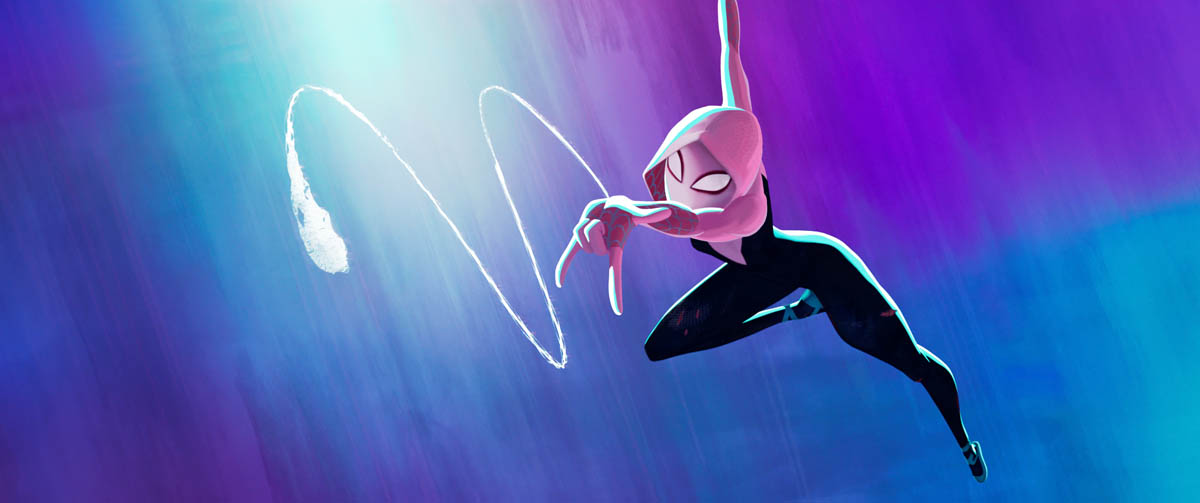
ANDREWS: It's definitely been crazy. I've had anxiety dreams about this in the past where I've been on a movie and we're working on it as it's coming out. The good news is we're not making any story changes. Our mix was literally pushed up to the deadline.
What happened on the Friday of the release was some of the filmmakers got on a bus and made a little mini tour around LA. We went to three different theaters, Phil Lord and Chris Miller got up and introduced the movie to the audience much to their surprise. It was really fun and it was great to hang out with those guys one more time. One thing we were discovering live as we were traveling around and as reports started coming in from the field, there was a lot of activity on Twitter about some mix issues with the movie.
The movie starts off with a bang with a lot of rock and roll music, Gwen playing drums and at the same time she's trying to narrate her story. So it was definitely a battle throughout, even when I was working on it, mixing it myself on the AVID. Then when we got on the mix stage it was a bigger battle because you're in a bigger space and it's more challenging to make everything read whilst also maintaining the energy level music. That whole scene is about getting in Gwen's head and carrying the emotion of it so we felt we needed to keep that music at a really energetic level. It did compete with her dialogue and some people noticed that. What we noticed which was much to our surprise, in all three theaters we found it was a different response and the mix sounded different. You’d think they would be more standardized but they're not. It's a wild card as to what you get. So that made us rethink things a little bit. Phil Lord was already on a Twitter mission to get projectionists to play it at 7.0 Dolby Standard.
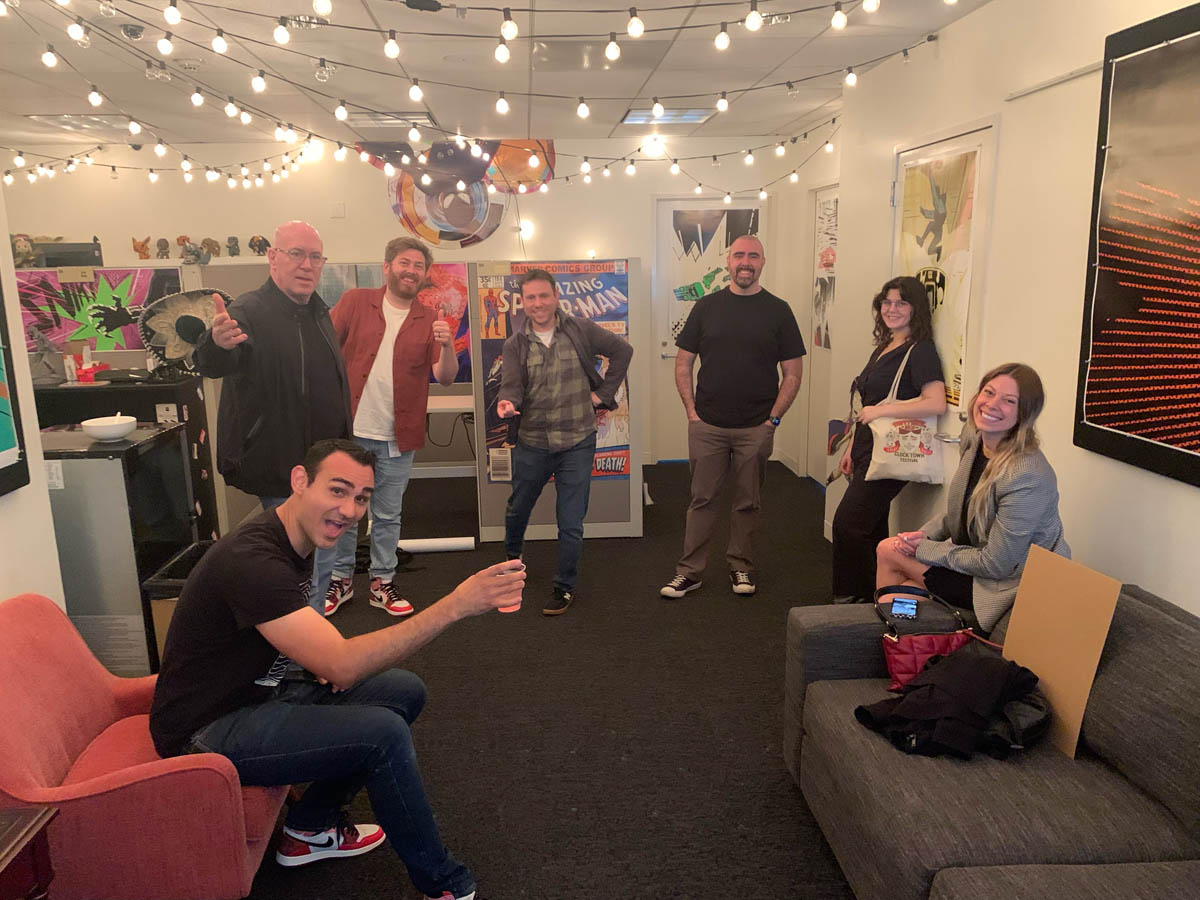
The only day that the post team were all in the edit suite together - after the release day.
Let's talk a little bit about the rest of the team that's involved. Tell me who else is there and some of the things that they were doing for you and for the movie.ANDREWS: So my editorial team consisted of six people. Myself, two associates and three assistants. It's actually the biggest editorial team I've ever worked with. With a movie of this size and the amount of changes we did, it was crucial to have all these people. My two associates are Andrew Leviton, who was an associate on the first movie. Chett Hoffman came in a little bit later but he was amazing. Andy and Chett do a lot of scratch voices along the way and come up with a lot of their own material, sometimes those things make it into the movie. Andy was notorious for one role of a villain called “Typeface.” Andy invented this great line for him, “Go to Helvetica, Spider-man!”
Oh dear! I bet he thinks he's a Comic ...Sans! I'm sorry I had to do that. (Laughing)ANDREWS: Very good! That's why Miles says Bold right after. (Laughing)
That's funny!ANDREWS: Chet did a really funny line, Spot had just popped into this Lego world and caused all this destruction. As we come back into the scene there's chaos on the street and Chet added a line "Does anyone have any instructions for this?" Which I thought was very funny. It's a lot of fun that they get to do that and sometimes they end up in the movie, which is fantastic.

Mike with Phil and Pete Ramsey
One of Phil and Chris’ initial successes was the Lego movie. They thought it'd be fun to have this beat of the Lego world and they certainly knew who to ask permission from to be able to do that. This was very late in the game by the way, we were already releasing trailers because we were trying to figure out what worlds Spot should go to. We had a ton of them. He pops in on a 1930s comic book world and then he pops in on the Venom world with the woman at the counter.
A 14-year-old boy from Toronto had recreated our trailer shot-for-shot out of Lego.
Wow.ANDREWS: He's using a computer much the way that the Lego movies did but not actually physically doing stop motion, it was genius. We found out he's 14 years old, his name was Preston. They contacted him and said "Would you do a segment for the movie?"
Oh my gosh!ANDREWS: It had been storyboarded and we gave him the cut. He went crazy, did his own thing and sent it back. It was just adorable. We were like "How do you give a 14 year old notes" but we did it in the kindest way possible. We just wanted to nudge him in certain directions but we really wanted to give him the freedom to do what he wanted to do.
The "D" gets blown off the Daily Bugle sign by Spot as he comes through, a taxi cab crashes on the street but when you come back to the scene - and it took us a while to notice this - there's a chicken standing on top of a person laying in the street. The chicken is stealing their money.
You mentioned your two associates and now you've got three assistants.ANDREWS: Weirdly, I had an all-Italian assistant team. I had Erika Scopelli as my first assistant, Nina Lentini and Freddy Ferrari. All fantastic names. The one thing I made clear to my crew from day one was I was not gonna force anybody to come to work if they didn't want to. Sony did a fantastic job at setting everybody up at home with the ability to remote into their office machines.
For the most part I had a virtual crew around me, Freddy Ferrari I only met in person about three weeks ago. So they were all fantastic. Erica did an amazing job running the department and she had to handle so much in making this movie happen.
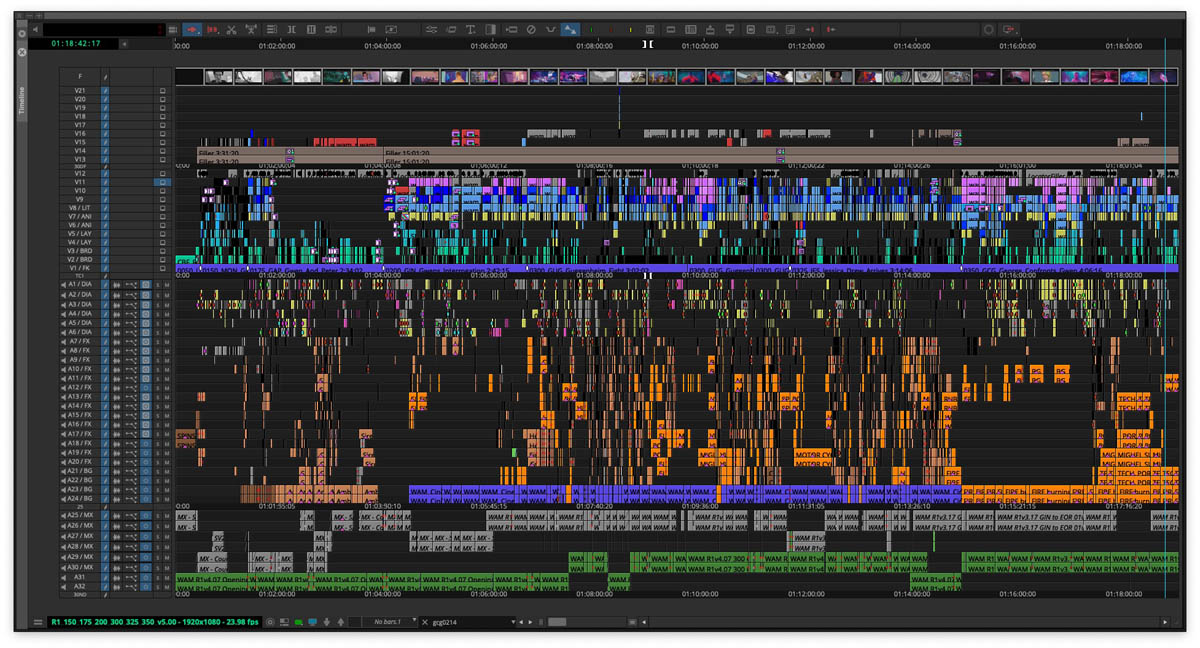 Avid timeline of the 5th screening
You sent along some timelines. It's a very different looking timeline for an animated film and I was wondering if you could walk us through both the video and audio tracks.
Avid timeline of the 5th screening
You sent along some timelines. It's a very different looking timeline for an animated film and I was wondering if you could walk us through both the video and audio tracks.
ANDREWS: There's a V1 track that I take claim to inventing but I'm sure I didn't. I like to say that I was the first one to do it, I'm sure it's not true. The V1 track is a fake clip that just identifies what sequence it's in. That makes it very easy for me to know where I'm at in the movie. The reason I do that is because I like to work in reels very early on. The moment I can, I like to build reels and just work big instead of going sequence by sequence because I feel like you can get trapped in sequences and spin for a while. It's better to just think about "Where are you going next? What comes after that?"
You and I would have to compete to see which one of us did that first because I've been doing that for a lot of years. Usually indicating where each page is in the timeline because I used to work in shorter form, so I would do pages. If somebody asked me about page five I can go right to page five because it's only 7 or 8 pages. I cut in a put a placeholder clip that was the length of each page, which let me know where each page started so that it was much easier to find where I needed to jump to.
Mike with Phil and Chris Miller
ANDREWS: That's very smart!
Great minds think alike.ANDREWS: Script wise in animation it's a little more arbitrary, it's not a good guide for me. It's great to look at an entire reel and jump anywhere I need to go.
Yeah, absolutely. Do it by sequence or by "Tent pole moments."ANDREWS: Markers are always great for that too and I'll throw those on to help me through. On top of that we have storyboards which often take up many tracks because we have to do so much layering. We're always cutting and pasting and creating shots out of thin air a lot of the time. Those pile up, I usually leave six tracks or so for that.
Then I leave a clean track for layout which is the next phase. Animation comes up on top of that and I try to collapse at some point. This movie was a little harder to manage in that way just because we had so much going on towards the end which is usually the time I start organizing.
After that lighting comes in and we keep stacking. The comps come in that go straight to the DI and they'll stack up on top so that we can compare those easily.
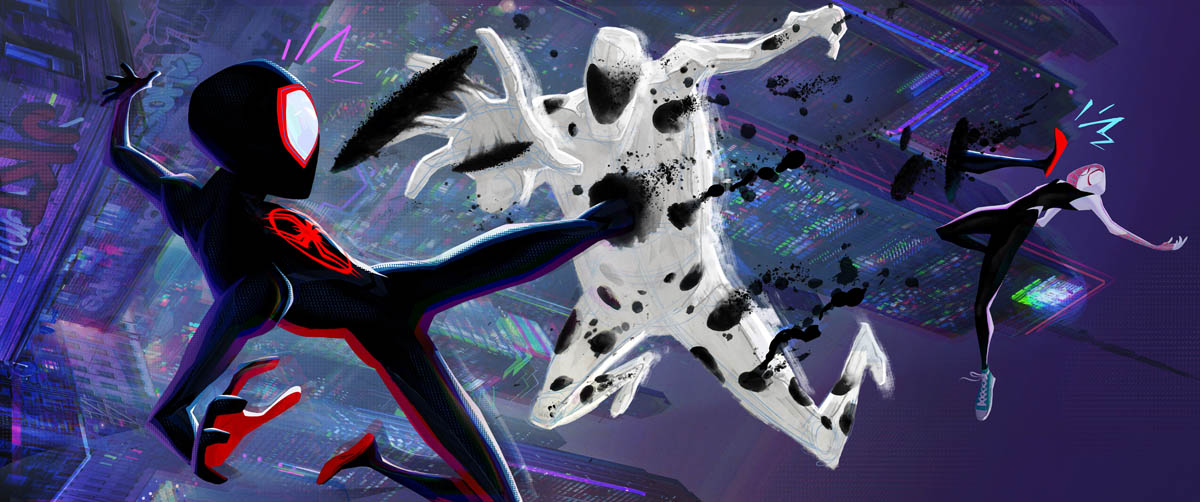 For those who aren't familiar with the difference between the animation pass and the "lighting" pass in animation, with the animation pass, they animate but don't worry about how realistic the lighting looks. So there's an animation pass where everybody is moving properly but it doesn't look nice... it's flat and plasticy.
For those who aren't familiar with the difference between the animation pass and the "lighting" pass in animation, with the animation pass, they animate but don't worry about how realistic the lighting looks. So there's an animation pass where everybody is moving properly but it doesn't look nice... it's flat and plasticy.
ANDREWS: It's all about the characters. Their movement and their speaking.
The lighting is like the look pass. It's like cinematography, instead of sitting under fluorescent lights, somebody actually does something cinematic.ANDREWS: Animation is sitting under the fluorescent lights, lighting is when they bring the mood, atmosphere and smoke.
Is there anything else above the lighting layer?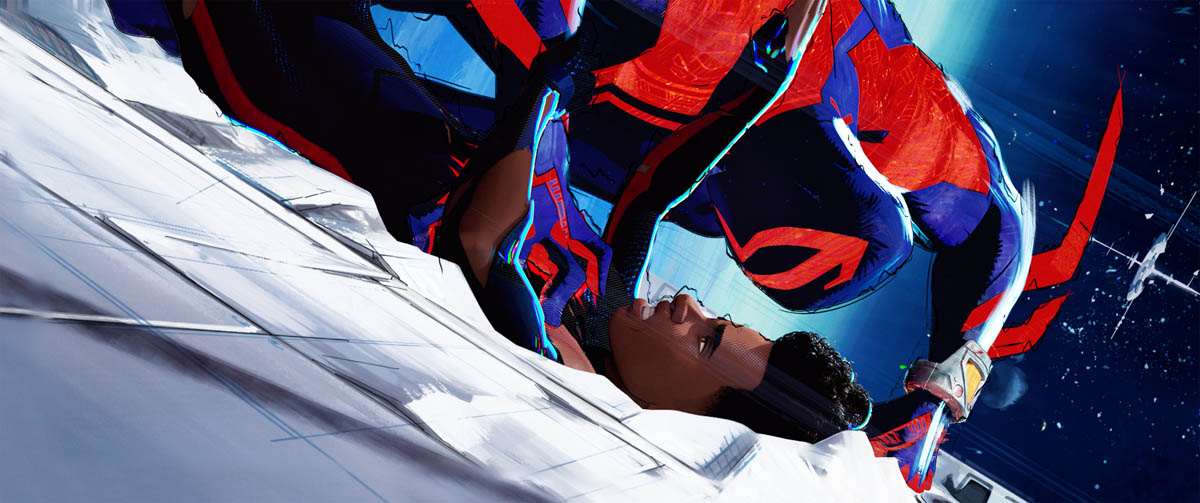
ANDREWS: There's just a mask and a filter that adds shot information. It takes all the metadata and it applies it to which version of the shot it is, it tells you the date and who's working on it. If you want more information you just turn the mask on.
Audio-wise, I maintain about 30 tracks. I just do mono and dual mono in stereo situations. I have about six tracks of dialogue more or less sorted by character. We use color coding on the clips so that we know what is production dialogue and what is scratch dialogue. Four tracks on the bottom for music.
Because you're still using left and right mono tracks for music?ANDREWS: Correct. Two tracks for dual mono which I use for all stereo situations, even if it's ambiance and effects. I tried doing a mixture of mono and stereo tracks one time and it just bothered me. I gave up on that very quickly. I just found it convoluted.
Yeah, I get that.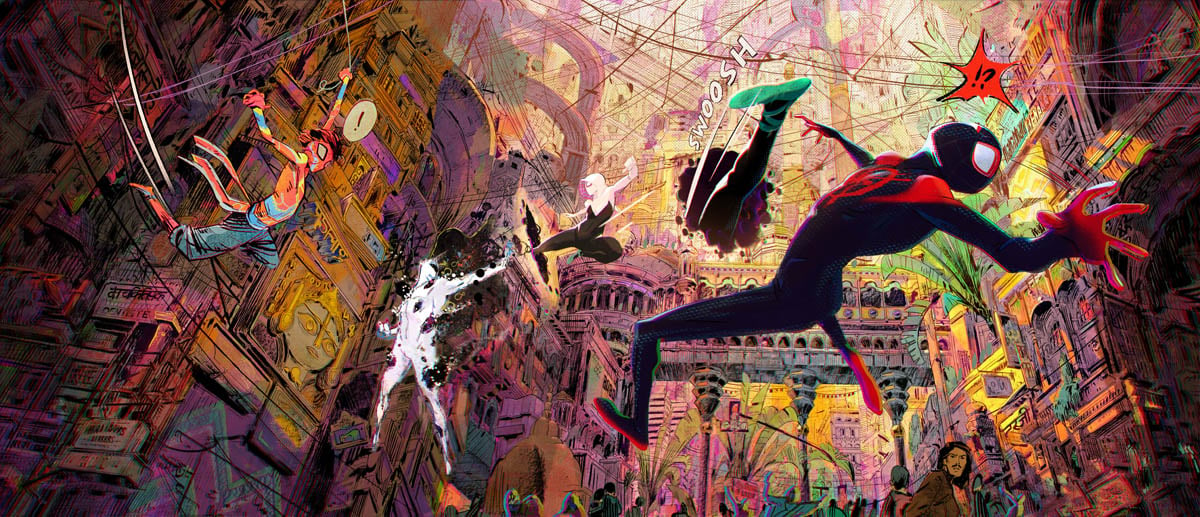
ANDREWS: I was going to show you a couple samples from the timeline so you see an earlier version where it was mostly still in storyboard. One thing I discovered when I was looking at them was that our first reel used to have much of the second reel in it. I realized it expanded that story for Gwen, she became the first reel entirely on her own. Even when we did that we realized people were going to want to know “What's going on with Miles?” We included as much reference to him as we could throughout that first scene, she asks Miguel “Can you go anywhere with that watch?” That idea was planted just to say she wants to go see Miles. It was just to keep him alive in a movie that people are expecting to see him in.
There were things earlier in the movie too. He does a little talk up on Miles Morales, it was just him introducing himself. The thing I love about Phil and Chris is they never want to do the expected. When they were talking to me about coming onto the movie, my first thought was "Wow, this is a lot of Gwen to start the movie off with." I soon realized that these guys are very smart. They're not doing what you expect, which is “Here's Miles, Here's what he's been doing.” They pushed that off and did a whole cold open with Gwen.
A very clever thing that Phil came up with was instead of just having Miles do a straight talk up of himself, then introducing Spot, then have him fight Spot in three consecutive sequences. He came up with the idea to make them all one. If you look at the numbering of the sequences they're even out of order and it's because we mixed things up.
That's so interesting editorially. Michael, thank you so much for filling us in on this movie. The editorial is amazing and I really appreciate this deep dive into an incredible feature. I hope everybody gets a chance to see it!ANDREWS: My pleasure! Thanks for having me.

